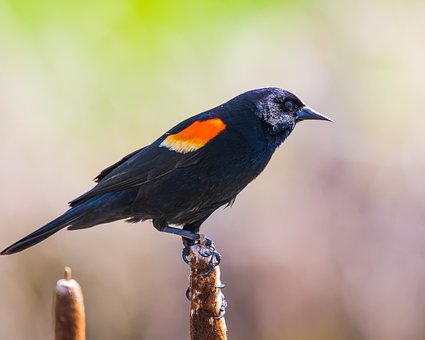ANIMAL: Red-Winged Blackbird Agelaius phoeniceus Type of Animal: Songbird Habitat: Marshes, watercourses, water hazards on golf courses, wet roadsides, meadows, fields, feedlots, pastures, swamps, cultivated land, water edges, open mudflats, agricultural areas, prairies, bogs, wetlands, suburban areas, plantations, alfalfa/hay areas, rice paddies, grassland, sparse/light deciduous forest, wooded areas along waterways, oil fields, open patches in woodlands, roadside ditches, edge of secondary growth, urban parks Location(s): Found in North America, Mexico, parts of Central America, & W Cuba Appearance: Males black to glossy black w/ distinct red & yellow shoulder patches on wings & black bill. Females crispy streaked & dark brownish being paler on the breast & lighter colored bills, some females have subdued reddish or rusty tinges on shoulder. Both sexes have sharply pointed bills & rounded tails. Nonbreeding males have rusty feather edges and/or incomplete red shoulder patches w/ more noticeable yellow. Many breeding males also have nonbreeding coloration in winter. Many males more streaky black in winter. Male birds in parts of California & N Mexico lack yellow border, only having red on shoulder patches. Food/Diet: Seeds, grains, corn, suet, insects, grubs, snails, millipedes, spiders, worms, fruit, berries, nuts, eggs, young birds, frogs, carrion, mussels, crayfish, lizards Status in Wild: Stable Conservation: Some protections from Migratory Bird Treaty Act Lifestyle: Flocks range from 25-2,000,000 birds. Larger flocks occur outside of breeding/nesting season. Males territorial during breeding/nesting season, guarding 1-15 females. Though territorial, males often nest in close proximity to each other & loose colonies are not uncommon, w/ some numbering thousands of birds. Additional Info: Called: Male: Cock Female: Hen Young: Chick Group: Flock Weight: Male: 2.3-2.5 oz Female: 1.46 oz Gestation: 2 weeks Life Span: 2-12 years Height: Male: 8.7-9.4 in Female: 6.7-7.1 in Body Length: Male: 8.7-9.4 in Female: 6.7-7.1 in Tail Length: Male: 4.3 in Female: 2.4 in Main predators of adults are raptors, raccoons, snakes, skunks, cats, dogs, coyotes, foxes, bears, crocodilians, mink, weasels, otters, corvids, & shrikes. Marsh wrens prey on young chicks. As many as 3 broods can hatch in single breeding season, w/ each brood having 2-4 chicks. Chicks fledge at 2-3 weeks but stay w/ parents for a little while longer. Sexual maturity reached at 10-12 months old, w/ females maturing before males. When singing to defend territory and/or attract female, male fluffs red patches & half-spreads wings displaying red & yellow feathers. Males known for raspy calls & these calls often seen as sign of spring. These birds are some of the most common & abundant birds in North America. Fun Fact(s): These birds can cause an estimated $150,000,000 per year in crop damage due to feeding habits & flock size. While crop pests, these birds can be beneficial since they eat invertebrate crop pests. These birds often bully & displace smaller birds at bird feeders. Males can be aggressive during breeding/nesting season, even dive-bombing people. These birds will mob predators much larger than themselves.
